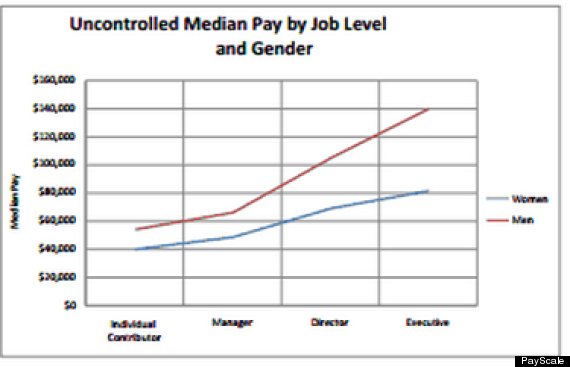Men and women who work the same job actually get paid about the same when they are starting out in their careers, according to a study released Thursday. However, the study said, as workers move up the ranks, men's wages start to increasingly outpace those of their female counterparts.
The survey from salary information site Payscale appears to contradict a wide body of research on the gender wage gap. Still, the survey's lead researcher, economist Katie Bardaro, told The Huffington Post it's a "misbegotten myth" that a man working the same job and with the same background as a woman would get paid more.
“The gender wage gap does not exist in the way people believe it does,” Bardaro said. “However, it does persist for director and executive-level positions.”
The PayScale analysis, which relied on career profiles of the site's 40 million users, found that women working various non-managerial jobs earn about 98 percent of what men do on average. But once workers become executives, that share shrinks to about 91 percent, according to the study. The findings add dimension to previous analyses of Bureau of Labor Statistics and Census data, which estimate that women are earning as little as 77 to 80 percent of what men make overall.
PayScale came to its conclusion by controlling for factors like education, jobs and responsibilities between men and women. Still, the analysis contradicts other studies that indicate women who graduate from the same college with the same major and take the same jobs as men make less than they do. The PayScale findings are based on responses to the salary information company's own data, while other measures of the wage gap are often based on data from government agencies.
It's possible that PayScale's findings differ from other conclusions because its study is based on people who choose to report their information to the site, as opposed to the Census and BLS, which have a broader reach.
Heidi Hartmann, president of the Institute For Women's Policy Research, told HuffPost that researchers can estimate the gender wage gap while controlling for variables that appear to make it smaller. But, she said, the reality is that much of the difference between the wages of men and women can't be explained by objective factors like experience and education -- demonstrating that discrimination is still preventing women from earning the same as their male colleagues.
Even models that control for variables like occupation and education aren't necessarily free from subjective discrimination that can affect the difference in pay between male and female workers in the real world, Hartmann said.
"It's clear the problem is still there," she said, noting that if there was no discrimination present in the labor force, women and men would be making the same amount across the board.
Still, the PayScale survey backs one theory that's been floated before: Women could be earning less because they’re less likely to have high-level positions and tend to be clustered in lower-paying sectors. Just 4 percent of CEOs at S&P 500 companies are women. By contrast, women hold nearly two-thirds of low-wage jobs, according to the National Women’s Law Center.
In addition, there are only seven occupations in the U.S. where women typically make more than men, according to a recent analysis from the Center for American Progress.
“The real issue here is not the gender wage gap, but more the jobs gap,” Bardaro said. “People are filling positions according to gender, with higher-paid positions being filled by men and lower-paid positions being filled by women.”
The economic recovery has exacerbated that gap, according to a study from the Institute for Women’s Policy Research. As state and local governments with tight budgets eliminated jobs that were often held by women, largely male-dominated sectors like construction experienced a rebound, the study said.
Despite the fact that female-dominated sectors tend to pay less, there may be an incentive for women to take a job in one of those fields, according to the PayScale data. Women working in female-dominated jobs like health care, social assistance, education and real estate are more likely to ask their bosses for a raise or a promotion, PayScale found.
Check out these charts from the PayScale survey:


Original Article
Source: huffingtonpost.com
Author: Jillian Berman
The survey from salary information site Payscale appears to contradict a wide body of research on the gender wage gap. Still, the survey's lead researcher, economist Katie Bardaro, told The Huffington Post it's a "misbegotten myth" that a man working the same job and with the same background as a woman would get paid more.
“The gender wage gap does not exist in the way people believe it does,” Bardaro said. “However, it does persist for director and executive-level positions.”
The PayScale analysis, which relied on career profiles of the site's 40 million users, found that women working various non-managerial jobs earn about 98 percent of what men do on average. But once workers become executives, that share shrinks to about 91 percent, according to the study. The findings add dimension to previous analyses of Bureau of Labor Statistics and Census data, which estimate that women are earning as little as 77 to 80 percent of what men make overall.
PayScale came to its conclusion by controlling for factors like education, jobs and responsibilities between men and women. Still, the analysis contradicts other studies that indicate women who graduate from the same college with the same major and take the same jobs as men make less than they do. The PayScale findings are based on responses to the salary information company's own data, while other measures of the wage gap are often based on data from government agencies.
It's possible that PayScale's findings differ from other conclusions because its study is based on people who choose to report their information to the site, as opposed to the Census and BLS, which have a broader reach.
Heidi Hartmann, president of the Institute For Women's Policy Research, told HuffPost that researchers can estimate the gender wage gap while controlling for variables that appear to make it smaller. But, she said, the reality is that much of the difference between the wages of men and women can't be explained by objective factors like experience and education -- demonstrating that discrimination is still preventing women from earning the same as their male colleagues.
Even models that control for variables like occupation and education aren't necessarily free from subjective discrimination that can affect the difference in pay between male and female workers in the real world, Hartmann said.
"It's clear the problem is still there," she said, noting that if there was no discrimination present in the labor force, women and men would be making the same amount across the board.
Still, the PayScale survey backs one theory that's been floated before: Women could be earning less because they’re less likely to have high-level positions and tend to be clustered in lower-paying sectors. Just 4 percent of CEOs at S&P 500 companies are women. By contrast, women hold nearly two-thirds of low-wage jobs, according to the National Women’s Law Center.
In addition, there are only seven occupations in the U.S. where women typically make more than men, according to a recent analysis from the Center for American Progress.
“The real issue here is not the gender wage gap, but more the jobs gap,” Bardaro said. “People are filling positions according to gender, with higher-paid positions being filled by men and lower-paid positions being filled by women.”
The economic recovery has exacerbated that gap, according to a study from the Institute for Women’s Policy Research. As state and local governments with tight budgets eliminated jobs that were often held by women, largely male-dominated sectors like construction experienced a rebound, the study said.
Despite the fact that female-dominated sectors tend to pay less, there may be an incentive for women to take a job in one of those fields, according to the PayScale data. Women working in female-dominated jobs like health care, social assistance, education and real estate are more likely to ask their bosses for a raise or a promotion, PayScale found.
Check out these charts from the PayScale survey:


Original Article
Source: huffingtonpost.com
Author: Jillian Berman

No comments:
Post a Comment